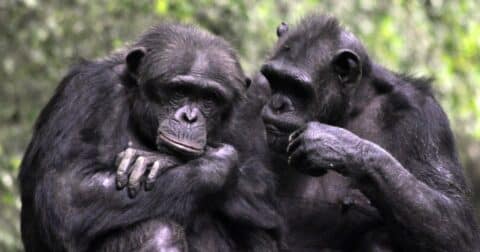News
GLP-1 Users Lose Weight, and Their Taste for Meat
Research•3 min read
Solutions
Advances in AI are paving the way for two-way communication with animals, with profound ethical implications.


Words by Steven Rouk
Recent advancements in artificial intelligence (AI) might enable us for the first time to directly translate from animal communication to human language and back again. Not only is this theoretically possible, but scientists are actively developing two-way communication with other animals. If we do gain this ability, it would have profound implications for animal rights, conservation and our understanding of animal sentience.
One definition of the word “communication” is “a process by which information is exchanged between individuals through a common system of symbols, signs, or behavior.” By this definition, humans have communicated with dogs for thousands of years to domesticate them. Animal domestication typically requires a lot of communication — such as telling your dog to stay or roll over. Dogs can also be taught to communicate various wants and needs back to humans, such as ringing a bell when they need to go to the bathroom.
In some cases, humans have already been able to have two-way communication with specific individuals using human language, such as when Koko the Gorilla learned to communicate using sign language. Grey parrots have also been shown to be able to learn and use speech at a similar level to very young children.
However, two-way communication of this sort often requires a lot of work to establish. Even if one animal learns to communicate with a human, this skill does not translate to other members of that species. We might be able to communicate limited information back and forth with our companion animals or with a specific Grey parrot or chimpanzee, but that doesn’t help us communicate with the multitude of squirrels, birds, fish, insects, deer and other animals roaming the world, each of whom has their own mode of communication.
Given the groundswell of recent progress in artificial intelligence, could AI eventually open up two-way communication between humans and the rest of the animal kingdom?
The core idea at the heart of modern artificial intelligence is “machine learning,” software that is good at finding useful patterns in data. ChatGPT finds patterns in text to generate answers, your photo app uses patterns in pixels to identify what’s in the photo, and voice-to-text applications find patterns in audio signals to turn spoken sound into written language.
It’s easier to find useful patterns if you have a lot of data to learn from. Easy access to massive amounts of data on the Internet is part of the reason why artificial intelligence has gotten so much better in recent years. Researchers are also figuring out how to write better software that can find more complex, useful patterns in the data that we have.
With rapidly improving algorithms and an abundance of data, we seem to have reached a tipping point in the last few years where powerful new AI tools have become possible, taking the world by storm with their surprising usefulness.
It turns out these same approaches can be applied to animal communication, too.
Animals, including human animals, make noises and body expressions that are all just different types of data — audio data, visual data and even pheromone data. Machine learning algorithms can take that data and use it to detect patterns. With the help of animal welfare scientists, AI can help us figure out that one noise is the sound of a happy animal, while a different noise is the sound of an animal in distress.
Researchers are even exploring the possibility of automatically translating between human and animal languages based on the fundamental properties of language itself — such as how words relate to each other to create meaningful sentences about the real world — potentially bypassing the need to interpret the meaning of individual sounds. While this remains a theoretical possibility, if achieved, it could revolutionize our ability to communicate with diverse species.
When it comes to collecting animal communication data in the first place, portable microphones and cameras have proven essential. Karen Bakker, author of the book The Sounds of Life: How Digital Technology Is Bringing Us Closer to the Worlds of Animals and Plants explained in Scientific American that “digital bioacoustics relies on very small, portable, lightweight digital recorders, which are like miniature microphones that scientists are installing everywhere from the Arctic to the Amazon…They can record continuously, 24/7.” Recording animal sounds using this technique can give researchers access to vast amounts of data to feed into powerful modern AI systems. Those systems can then help us discover the patterns in that data. The overly simplistic way to put it is: raw data goes in, information about animal communication comes out.
This research is no longer theoretical. The Earth Species Project, a non-profit “dedicated to using artificial intelligence to decode non-human communication,” is tackling the fundamental problems that are required to understand animal communications, such as collecting and categorizing data through their Crow Vocal Repertoire project and their Benchmark of Animal Sounds. The end goal? Decoding animal language, with an eye towards achieving two-way communication.
Other researchers are working on understanding sperm whale communications, and there is even research into honey bees that analyzes the body movement and sounds of bees in order to understand what they’re communicating. DeepSqueak is another software tool that can interpret rodent noises to determine when a rat is sick or in pain.
Despite the rapid progress and the proliferation of tools and research, many challenges lie ahead for this work. Kevin Coffey, a neuroscientist who helped create DeepSqueak, says “AI and deep-learning tools are not magic. They are not going to suddenly translate all animal sounds into English. The hard work is being done by biologists who need to observe animals in a multitude of situations and connect the calls to behaviors, emotions, etcetera.”
People who care about animal welfare are taking note of this progress.
Some foundations are betting money on the fact that interspecies communication is both possible and important for advancing the societal status of animals. In May, the Jeremy Coller Foundation and Tel Aviv University announced the Coller Dolittle Challenge for Interspecies Two-Way Communication, with a grand prize of $10 million for “cracking the code” on animal communication.
Dr. Sean Butler, the co-director of the Cambridge Centre for Animal Rights Law, believes that if this challenge is successful at unlocking animal communication it could lead to profound implications for animal law.
Other legal researchers agree, arguing that an understanding of animal communication could force us to reevaluate our current approaches to animal welfare, conservation and animal rights. If a chicken living in a modern factory farm could communicate distress caused by living amid ammonia fumes emitted from their own waste, for instance, it might cause farmers to reevaluate keeping so many birds packed together in the same building. Or, perhaps one day, it might even spur humans to reevaluate keeping them captive for slaughter at all.
Increasing our understanding of animal language could shift how people emotionally relate to other animals. Research shows that when humans take on each other’s perspectives, that leads to increased empathy — could a similar result apply between humans and nonhumans as well? Shared language is a primary way that people are able to understand the experiences of others; increasing our ability to communicate with animals could plausibly increase our empathy towards them.
Or, in some cases, it could make it even easier to exploit them.
Advances in AI could lead to significant positive shifts in the ways that humans treat animals, but they aren’t without concerns.
Some researchers worry that other animals might not be communicating in ways that translate meaningfully to human language. Yossi Yovel, a zoology professor at the University of Tel Aviv and the chair of the $10 million prize for two-way communication, has previously said, “We want to ask animals, how do you feel today? Or what did you do yesterday? Now the thing is, if animals aren’t talking about these things, there’s no way [for us] to talk to them about it.” If other animals don’t have the ability to communicate in certain ways, then that’s that.
However, animals often demonstrate their intelligence and capabilities in ways that are different from us as humans. In his book Are We Smart Enough to Know How Smart Animals Are?, primatologist Frans de Waal argued that humans have frequently failed to account for the abilities of other animals. In 2024, he said, “One thing that I’ve seen often in my career is claims of human uniqueness that fall away and are never heard from again.”
New studies from earlier this year show that animals and insects appear to have cumulative culture, or generational group learning, something that scientists used to think only belonged to humans. In some of the most rigorous research done to date on the topic of fundamental animal capabilities, researcher Bob Fischer demonstrated that even salmon, crayfish and bees appear to have more capacities than we usually give them credit for, and pigs and chickens can exhibit depression-like behavior.
There are also concerns about potential abuse of two-way communication technology. Industries that slaughter animals, such as factory farming and commercial fishing, may be incentivized to use artificial intelligence to increase production while ignoring less profitable uses that could decrease animal suffering. Companies could also use these technologies to actively harm animals, such as if commercial fishing boats were to broadcast sounds to attract sea life to their nets. Most ethicists would see this as a tragic result for research that aimed to achieve dialogue and mutual understanding — but it isn’t hard to imagine.
Given that artificial intelligence has already been shown to be biased against farm animals, it’s not hard to see how advances in AI could lead to worse lives for animals. But if artificial intelligence does help us crack the code on two-way animal communication, the impact could be profound.